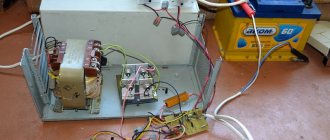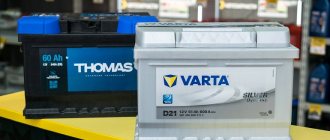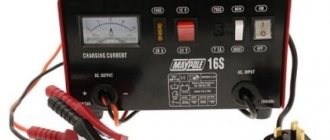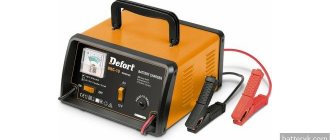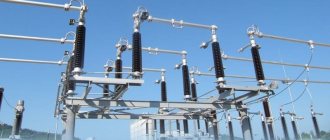Does a car owner need a spare part and why?
Many car enthusiasts drive for years without connecting the battery to a charger. Behind this is the practice of regularly replacing the battery with a new one; meanwhile, even direct instructions for cars require periodic recharging of the battery. This extends the life of the device and prevents performance deterioration.
All vehicles (except hybrid, electric and experimental) are equipped with lead-acid batteries. Today there are various technologies that improve the classic circuit, but they all require recharging.
The nature of the vehicle's operation also affects the mode of connecting the battery to the charger:
- When storing batteries, charge them to 100% once a year (twice a year in cold conditions).
- When using, it is advisable to charge the battery every 2 to 3 months.
When the battery is installed in its normal place in the car, it has a strong impact when the engine starts (spin up the starter and crankshaft flywheel). This is followed by charging from the generator.
However, there are other current consumers in the car - they take away part of the power, and the battery does not always have time to charge by an amount equal to the output. This results in constant undercharging, which is very harmful to a lead-acid power supply.
Expert opinion
Torsunov Pavel Maksimovich
The most vulnerable batteries are those that operate in start-stop mode. This means that after turning on the engine, the owner drives the car a short distance (for example, to work), where he parks for the whole day and, in the best case, repeats the trip in the evening in the reverse order. That is, there is a maximum discharge when the ignition is turned on, but charging from the generator is minimal.
The laws of chemistry and physics are inexorable: car batteries with lead electrodes and sulfuric acid as an electrolyte cannot be stored for a long time in a discharged state. And if it was still possible to do this with the old antimony models, even at home, then modern maintenance-free batteries with thickened electrolyte or fiberglass impregnated with sulfuric acid will simply “die” without timely charging.
Features of smart memory
The basis of the intelligent charger is high-tech electronics, thanks to which manufacturers managed to create a device with a fully automatic charging process. The device is a small device with intelligent recharging, controlled by a microprocessor. The microcontroller installed inside is programmed in such a way that the device can operate in different modes and with different protection.
Thanks to autocharging, the owner does not need to delve into how the charging cycles go, or make precise measurements during recharging in order to track changes in the charging current and voltage drop. The quality of charging depends on these indicators, which guarantees long-term operation of the battery. The main feature of a microprocessor-based smart charger is that the user only needs to know the battery capacity. The charging process is fully controlled by an intelligent device, the condition of the battery is assessed during charging, battery wear is taken into account, and how charging proceeds is monitored.
Hyundai car charger for batteries
If we compare the charging process using a standard pulse charger, the battery can charge up to two days. In this case, you need to ensure that the electrolyte level corresponds to the norm, and the charge current is not exceeded by the device. In this case, the device charges the car battery to the nominal value, and then the discharging process begins. During the charging process, the battery may boil and short-circuit. If the charging technology is not followed, the battery plates may fall off.
The big advantage of smart charging devices is that they can be used to charge batteries of any type: antimony, calcium, helium and AGM. Due to the absence of a coil in the design of the device, it became possible to make them compact and lightweight. Mostly their weight does not exceed 600 grams. The most powerful adaptive intelligent memory weighs no more than 1.5-2 kg.
The disadvantage of smart devices can be considered the impossibility of repairing on your own if a breakdown occurs. The device can only be repaired in a specialized center, since its repair requires certain knowledge, special equipment and software. Therefore, repairing it at home is impossible. In addition, many devices have cases that are sealed to completely prevent moisture from getting inside.
Please note that full charging using an auto charger takes several hours and it will not be able to charge the battery in an emergency. If you need to charge the battery before work, you will have to wait a little. To avoid this situation, you should check the battery charge at least once a month.
Automatic charging for car battery
Operating principle and modes
The intelligent memory differs from standard analogues in the principle of its operation. During the first five hours, all main auto-charging cycles take place. Then the autocharger evaluates the capacity and condition of the battery and finishes the charge, setting the parameters and current characteristics according to the condition of the battery. This takes another 2-3 hours.
Many smart chargers have an adaptive auto-charge mode. In this case, it may take 50 to 90 minutes to fully charge. The time it takes for the battery to be fully charged depends on the condition of the battery and what its capacity is. The device will signal when fully charged. The type of signal depends on the model: it can be a light signal or a corresponding inscription will be displayed on the screen. After this, the device goes into floating mode.
Many experts do not believe that a charger can charge a battery in 50-90 minutes without harming it. Knowing that a 60A battery needs to be charged with a current of 6A for 10 hours, and if the current is higher, then we add plates.
Unlike transistor chargers, a charger with a microcontroller can treat sulfated batteries.
Intelligent car chargers with a computer unit have the following functions:
- Desulfation. During this mode, the charger conducts a pulse charge, which destroys solid sulfate crystals that form when the battery is completely discharged or left idle for a long time.
- Soft start. The charger clearly controls the state of the battery, providing constant recharging that does not exceed a charging voltage of 12 V.
- Test mode. During charging, the microprocessor runs several tests, based on the results of which it decides on the next charging stage. In this case, the type of charging is selected. It can be impulse or smooth.
- Recovery mode. This mode is used to restore the capacity of dead batteries. Moreover, even the most hopeless batteries are restored.
Microprocessor battery charger
When choosing a smart charger, consider the following factors:
- it is better to give preference to models that have at least a small supply of charging current;
- You should buy devices from well-known manufacturers;
- it is advisable to choose a device that operates both in standard smart mode and functions as a stabilizing power source;
- the best choice is combined models;
- You should pay attention to the indication, weight and dimensions of the device.
Purchasing a charger will allow you to save on the purchase of a new battery, since there are no restrictions on the use of the device, and it is suitable for charging any type of battery.
Loading …
What are there
Depending on the output values and available modes, all devices for connecting to the battery are divided into three types:
Launchers
Designed to start the car when the original battery is discharged. A common practice in such cases is to ask neighbors in the parking lot to “light up” from another car. And although the unwritten code of roads prescribes responding to such requests, in practice not all drivers agree to meet them halfway. In addition, at a particular moment there may simply be no one nearby.
Jump batteries are portable batteries. Unlike those that are placed under the hood, these are made using lithium-polymer power source technology. Thanks to an electronic converter, such a miniature device, which looks like a heavy Power-Bank, can produce a short-term current of 200 - 800 A. This is quite enough to crank the starter, after which the generator begins to charge.
The rest of the time, the device allows you to charge smartphones and tablets, and often has a built-in flashlight.
Starter-chargers
These are powerful devices that have universal value: they can start the engine by delivering peak current and charge the battery for several hours at values of tens of percent of the battery capacity. All of them operate from a 220 V network, converting alternating current into direct current. Advanced functionality significantly affects the cost: among all chargers they are the most expensive. They are best suited for those car owners who have their own garage or use more than one car.
Pre-launch
They also require plugging into an outlet, but their electrical circuits are not designed for heavy loads. The maximum they can produce does not exceed the nominal capacity of a standard 12-volt battery for a passenger car: 50 - 60 A. The purpose of this device is more regular maintenance than emergency situations. But the simpler design and the absence of expensive components had a positive effect on the price.
A few words about the “filling”
Inside the charger case there are hidden “guts” that the average user rarely gets into. True, many craftsmen are modifying chargers and even making new ones. But for those who use the car only as a means of transportation, there is simply no time or desire for modifications. Therefore, it is better to immediately determine what is inside.
Transformer
Warm, lamp-like, grandfatherly. For several decades they have remained unchanged. Today, such devices are practically not produced, because they are outdated - batteries can be charged using cheaper and more technologically advanced methods. In addition, the transformer version is material-intensive - how much metal goes into a powerful transformer!
Such devices have their own loyal audience. They love transformer chargers for their indestructibility, predictability and lack of complex electronics (only rectifiers and resistors). Repair of such devices can be done independently by a person with basic electrical knowledge and soldering skills.
The lack of automation unexpectedly has its advantage. Where the device on microcircuits considers a modern gel battery to be out of order, the transformer machine will “stoker” it with a given current of a given value. Of course, such a process must be under the special control of the user in order to avoid emergency situations.
Pulse
Today they make up the majority of the market. Inside there is a control board that controls the supply of current with the required parameters to the battery terminals. They have significantly less weight, and due to the cheap cost of electronic circuits (assembled in China), they can be very cheap (depending more on the brand and positioning of the model on the market).
Recommendations for recharging
- When recharging the battery with a powerful rectifier, you should constantly monitor the voltage, which will prevent sulfation of the plates and subsequent failure of the battery.
- When transporting the battery, do not turn it over or place it on its side. The battery must always maintain its horizontal position.
- If possible, activate the auto-charging mode, when the electronics fully regulate the current, lowering it as the battery capacity increases.
- You can easily use an old Soviet charger that produces high-quality voltage, and thanks to the presence of a voltmeter, working with such devices is greatly simplified.
Read also: Wire stripping pliers
Eight automatic rectifiers were found for low batteries - which one is better? The author compared and found fault.
Automatic or manual mode
Experienced car enthusiasts who have a good understanding of the operating principles of lead-acid batteries prefer to maintain full control over the operation of the charger. Units with a choice of parameters allow you to stepwise or smoothly regulate voltage, current, and activate various modes.
What car battery charger do you use?
TransformerPulse
Automatic devices read battery data when connecting the terminals. The indicators are voltage, current, capacity and resistance of the battery. The device independently selects the most suitable mode. This is an excellent option for those who do not want to bother themselves with studying the theory of electrochemistry and also “do magic” on the battery.
We make a battery charger
Making such a rectifier is not difficult. The cost of the spare parts used is minimal, so you can save significantly compared to purchasing a ready-made factory device.
Read also: Mini USB power connector
For this job you will need:
- Soldering iron and soldering kit.
- Several strong wires.
- Diode assembly and winding transformer.
- Wire discharge rheostat.
- Quenching capacitor.
- Capacitor battery.
- Hydrometer to check charge level.
Making a power supply
The power supply can easily be made from a diode assembly and two winding transformers. Transformers are connected to a diode and thyristor bridge, which allows you to reduce the voltage level to the required values. We will adjust the current using a rheostat. Remember that ceramic cores or variable resistors cannot withstand such a load, so they should not be used in battery rectifiers.
You can simplify the manufacture of the charger by using power supplies from old computers. Such units provide the necessary stable voltage, they are completely safe to use and are easy to connect to a thyristor unit, which will rectify the voltage. You just need to remember that such power supplies are designed for a current of no more than 2 Amps, so you can only charge a low-power charger.
Voltage regulator
The use of a wire rheostat allows not only to optimally reduce the output voltage, but also solves the problem of large heat generation from excess power. Unfortunately, the efficiency of such devices is not very high; accordingly, our rheostat will be a weak link that often breaks and requires replacement. However, the wire rheostat is enough for 5-10 recharges, and then, literally for pennies, you can purchase similar parts and repair a failed rectifier.
The only nuance of using such a wire rheostat is that the battery is charged at a lower current, and this leads to a slight increase in the duration of such work.
Accordingly, if you can charge a battery with purchased devices literally in a day, then with the help of a homemade rectifier such work can take one and a half to two days.
Automatic charge control
It is the correct charge control and change in current strength that is one of the conditions for the battery to gain capacity, which subsequently easily starts the car engine. It is necessary to connect a voltmeter or special devices for automatic charge control to the car charger circuit. Such a diode bridge, which is responsible for charge control, is made using variable resistors R 4, which are connected to relay K2, which allows you to turn off the load when a certain battery capacity is reached.
Additionally, the rectifier can be equipped with a capacitor bank, which reduces or adds capacity and allows you to significantly speed up battery charging . The presence of such a capacitor bank makes it easy to regulate the output current, and the device itself will be distinguished by its versatility, which allows it to be used to work with batteries of various capacities. The use of such a capacitor bank also allows us to solve problems with parasitic heating, which can cause a lot of trouble when the rectifier is operating at maximum current levels.
If desired, on the Internet you can find dozens of different designs for power supplies and the entire charger for car batteries, which will differ in the components used and the principle of operation.
It is only necessary to carry out all such rectifiers in strict accordance with the existing battery charging circuit, which will both ensure the safety of using electrical appliances and prevent battery failure due to the supply of high power current to it.
Additional functions
They make the charging process more convenient and the operation of the device more informative:
- Desulfation function. When the battery is discharged, the active mass of the battery oxidizes, forming sulfates. When charged they are destroyed. If the battery is in a discharged state for a long time, sulfation occurs, that is, the formation of more stable compounds that are no longer so easy to destroy. They clog the cells of the separator (separator between the anode and cathode) and deteriorate the properties of the battery. A special mode ensures that the plates are exposed to periodic short-term charge-discharge cycles. Within a few hours of this process, most of the sulfates disintegrate.
- Availability of display. Allows you to monitor the current charge current, and in advanced devices information about the current mode is displayed on the screen, including initial data about the connected battery.
- Presence of a dial indicator. In the absence of a full-fledged display, analogue indicators can be installed in simpler devices. Usually this is a voltmeter and ammeter, which show the strength of the charging current and its voltage.
Expert opinion
Torsunov Pavel Maksimovich
When connecting a discharged battery to a charger, the current will be high and the voltage will be low. As the capacitance increases, the values will change in the opposite direction: the current will drop and the voltage will rise.
The best jump starters with a built-in battery
70mai Midrive PS01
- for 12 V car batteries;
- maximum starting current 600 A;
- built-in battery capacity 11000 mAh;
- built-in flashlight, charging mobile devices (Powerbank);
- LED indication;
- 1xUSB connector, USB Type-C;
- weight 0.414 kg.
One of the most affordable starting devices. Despite its miniature size, the device copes well with starting gasoline cars and even diesel engines up to 2.5 liters. The form factor allows the launcher to be used as a regular PowerBank - there are appropriate connectors for this.
Fubag Drive 400
- for 12 V car batteries;
- maximum starting current 400 A;
- built-in battery capacity 10000 mAh;
- built-in flashlight, charging mobile devices (Powerbank);
- weight 0.3 kg.
The parameters of this device are somewhat more modest, but this does not prevent it from starting engines of up to more than two liters in frosts down to -15°C. For larger values, there is already a risk that it will not start on the first try. The kit includes wires and terminals, which are sufficient to complete the assigned tasks.
CARKU Pro-60
- for 12 V car batteries;
- maximum starting current 1500 A;
- built-in battery capacity 25000 mAh;
- built-in flashlight, charging mobile devices (Powerbank);
- weight 0.82 kg.
The specimen is quite weighty – a little more and it would have been a kilogram. As users joke, this is still much less than lugging a battery home into a warm place. But the capacity and starting current are enough even to start quite powerful diesel engines of up to 3 - 3.5 liters in quite cold weather. There is a high price to pay for a portable miracle.
Best pre-chargers
AVS Energy BT-6025
- for car batteries 6/12 V;
- charging batteries 5-100 Ah;
- built-in ammeter;
- weight 1.15 kg.
Inexpensive, pretty nice device - simple but reliable. There are not many manual settings available to the user - this is switching from 6 to 12 V, as well as a variable resistance knob, which is responsible for the current strength.
There is a dial ammeter, as well as a status indication. The charger will be useful for those who, in addition to a car, have a scooter or ATV with a 6-volt battery.
Vympel 57
- for car batteries 6/12 V;
- charging batteries 10-220 Ah;
- charging current 0.80-20 A;
- manual adjustment of current and voltage;
- pre-charging, built-in voltmeter, built-in ammeter;
- protection against polarity reversal, overheating, short circuit;
- digital display;
- weight 1 kg.
It is not without reason that chargers under the Vympel brand are among the most popular in Russia. Despite the outdated design and occasional manufacturing defects, these are functional and reliable devices. There is a digital display, as well as separate control of voltage and current. The terminals with wires and the power cord are hidden in the housing.
Bosch C3
- for car batteries 6/12 V;
- charging current 0.80-3.80 A;
- suitable for AGM/GEL batteries, automatic charging shutdown.
And this is an example of the European approach - full automation. One single button on the body, backlit. Everything is on microcircuits. It’s very convenient – you connect and get the result.
Dissatisfaction begins only after an attempt is made to use the charger “in Russian” - to restore sulfated batteries, or when reviving a battery that has “dropped” to 8 Volts (Bosch recognizes them as 6-Volt). But in Europe no one bothers with this - that’s not the right approach.
Question answer
Is this a danger for new GEL or AGM batteries?
Although they do not contain an electrolyte in the liquid vase, gases are still released. Since there are no necks with caps, this can lead to critical swelling of the body.
To what voltage should charging be carried out?
Usually this indicator is from 14.4 to 15 V. Anything higher leads to boiling of the electrolyte.
What are the safety precautions when charging a battery?
If you exceed the current at the terminals when the battery is almost charged, boiling may begin - the process of releasing hydrogen and oxygen, the components of an explosive mixture. Therefore, during the process it is necessary to well ventilate the room where charging is taking place and avoid sparks.
A car owner who takes care of his car must have a battery charger, and what kind it will be depends on personal preferences and operating conditions.
It’s also important to know: 3 nuances about operation
The homemade product differs somewhat in its method of operation from the factory version. This is explained by the fact that the purchased unit has built-in functions that help with operation. They are difficult to install on a device assembled at home, and therefore you will have to adhere to several rules during operation.
- A self-assembled charger will not turn off when the battery is fully charged. That is why it is necessary to periodically monitor the equipment and connect a multimeter to it to monitor the charge.
- You need to be very careful not to confuse “plus” and “minus”, otherwise the charger will burn out.
- The equipment must be turned off when connecting to the charger.
By following these simple rules, you will be able to properly recharge the battery and avoid unpleasant consequences.
